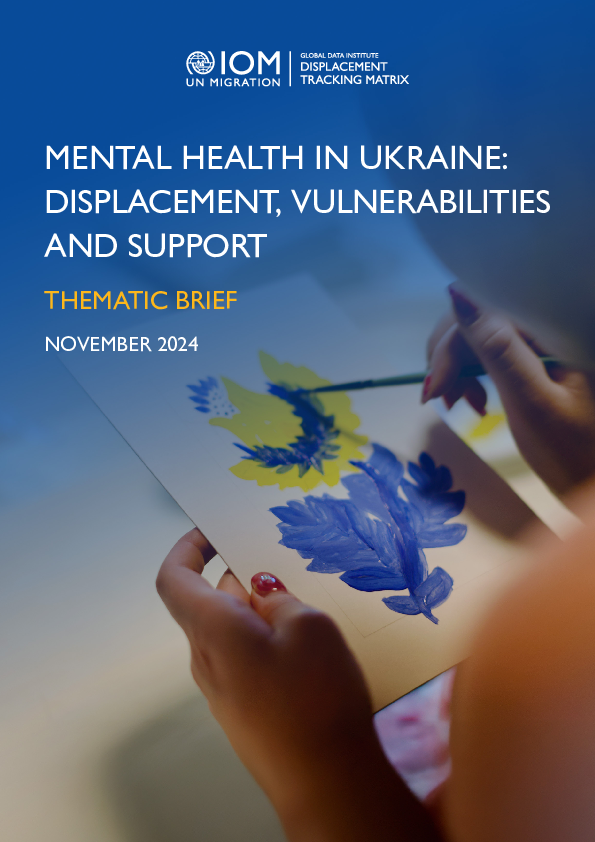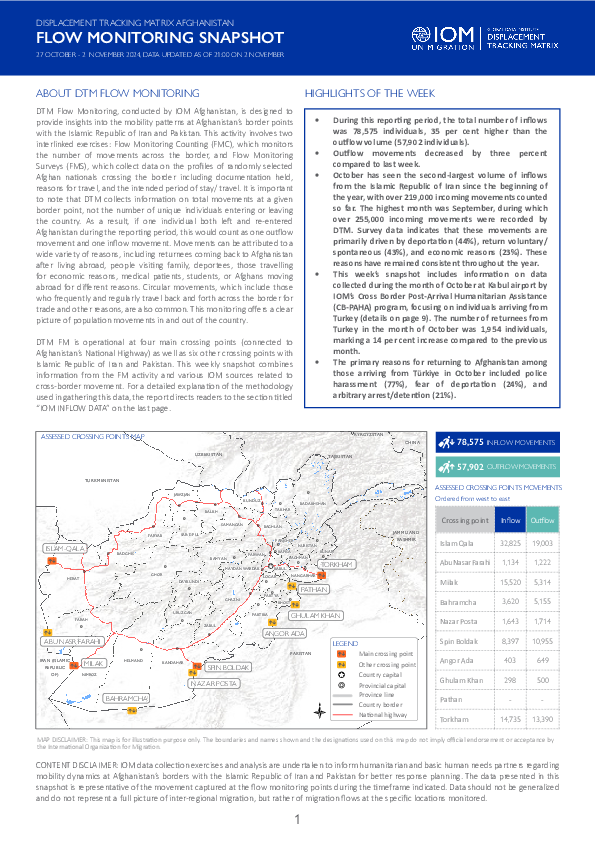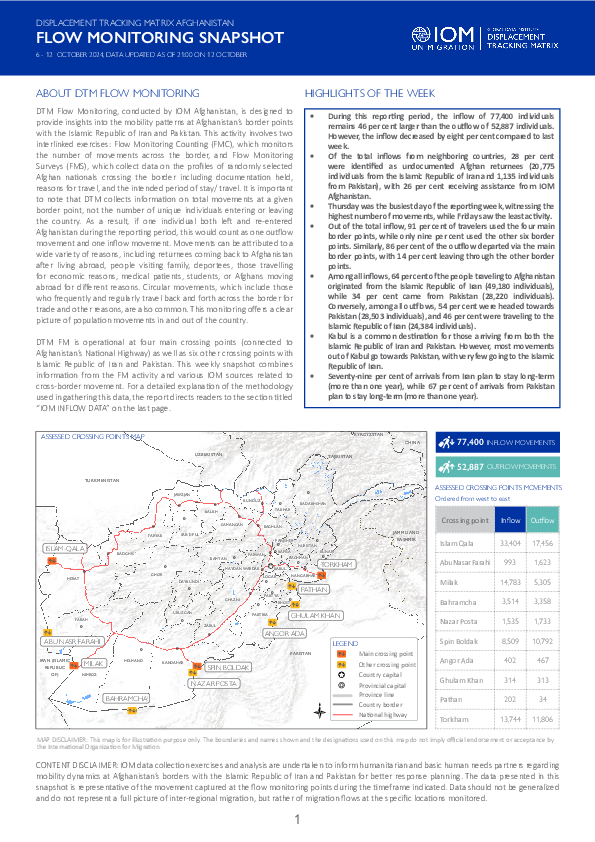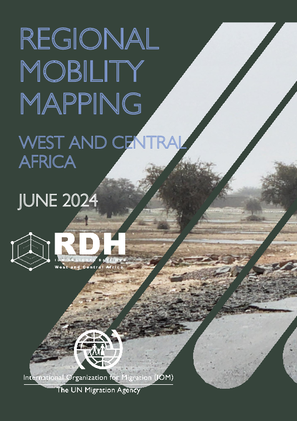-
Countries
-
Data and Analysis
-
Special Focus
-
Crisis Responses
Survey
Le développement et la mise en œuvre de programmes et politiques migratoires favorisant une migration sûre, ordonnée et légale en Afrique de l’Ouest et du Centre requière une meilleure compréhension des mobilités humaines dans la région.
La mobilité régionale prend différentes formes. La transhumance, la migration saisonnière lors des saisons des récoltes et des extractions de minerais, la migration économique à destination de l’Afrique du Nord et de l’Europe, les mouvements liés aux fêtes religieuses et culturelles, le tourisme, les mouvements étudiants, les déplacements forces, l’exode rural, et les migrations environnementales, sont des exemples de mouvements observes en Afrique de l’Ouest et du Centre, reflétant la diversité de la mobilité dans la région.
Ce rapport a pour tâche de fournir un aperçu des dynamiques, des tendances et schémas migratoires en Afrique de l’Ouest et du Centre et au-delà. Le rapport est mis à jour de manière régulière afin de fournir les dernières informations concernant les mobilités régionales.
Les cartes présentées dans le rapport ne servent pas qu’à établir des informations sur les mobilités dans la région. Elles fournissent également des données qui peuvent orienter la mise en œuvre de programmes d’assistance aux migrants (protection, gestion des flux de transhumance, retour des populations déplacées et l’élaboration de politiques migratoires fondées sur des éléments factuels.
The development and implementation of policies and programmes in West and Central Africa promoting safe, orderly and humane migration require a better understanding of human mobility in the region.
Human mobility in the region take many different forms. Transhumance, seasonal migration conducted during the harvesting season, travel during religious festivities, tourism, economic migration to North Africa and Europe, the search for employment in the mining industry, forced displacements due to conflict, natural disasters or climate-related migration, rural exodus, are all examples of movements observes in West and Central Africa and show the many faceted nature of mobility in the region.
This document is an attempt to provide a dynamic and regularly updated portrait of mobility within, from and to West and Central Africa regionon for Migration (IOM), the United Nations Department of Economic and Social Affairs (UNDESA) and the United Nations High Commissioner for Refugees (UNHCR).
The maps contained in this document are not only meant to inform on ongoing mobility patterns, but also provide information to support direct programming (protection of migrants, management of transhumance flows, support to safe returns of displaced people) and policy.

Contact
DTM Ukraine, dtmukraine@iom.int
Language
English
Location
Ukraine
Period Covered
Jul 13 2024
Aug 12 2024
Activity
- Survey
As of October 2024, an estimated 3.6 million people remain internally displaced in Ukraine, while 4.3 million previously displaced people have returned to their primary place of residence (IOM GPS R18). The war continues to have a significant impact on the country’s economy and on people’s livelihoods and living standards.
The protracted nature of the conflict and the uncertainty about the future it creates, together with unfavorable economic conditions, are expected to have a significant and lasting impact on the mental health of the Ukrainian population. Against this backdrop, this brief provides an overview of the population groups most at risk of experiencing symptoms of depression, examining factors such as gender, age, and disability. It also explores the relationship between mental health and displacement status, as well as individual and household-level socioeconomic characteristics, and outlines support needs. Finally, the brief presents recommendations for mental health and psychosocial support (MHPSS) programming across Ukraine, aiming to inform targeted assistance to address the pressing mental health challenges facing vulnerable populations affected by conflict

Contact
DTMAfghanistan@iom.int
Language
English
Location
Afghanistan
Period Covered
Oct 27 2024
Nov 02 2024
Activity
- Survey
- Flow Monitoring Survey
- Flow Monitoring
DTM Flow Monitoring, conducted by IOM Afghanistan, is designed to provide insights into the mobility patterns at Afghanistan’s border points with the Islamic Republic of Iran and Pakistan. This activity involves two interlinked exercises: Flow Monitoring Counting (FMC), which monitors the number of movements across the border, and Flow Monitoring Surveys (FMS), which collect data on the profiles of randomly selected Afghan nationals crossing the border including documentation held, reasons for travel, and the intended period of stay/ travel. It is important to note that DTM collects information on total movements at a given border point, not the number of unique individuals entering or leaving the country. As a result, if one individual both left and re-entered Afghanistan during the reporting period, this would count as one outflow movement and one inflow movement. Movements can be attributed to a wide variety of reasons, including returnees coming back to Afghanistan after living abroad, people visiting family, deportees, those travelling for economic reasons, medical patients, students, or Afghans moving abroad for different reasons. Circular movements, which include those who frequently and regularly travel back and forth across the border for trade and other reasons, are also common. This monitoring offers a clear picture of population movements in and out of the country.
DTM FM is operational at four main crossing points (connected to Afghanistan’s National Highway) as well as six other crossing points with Islamic Republic of Iran and Pakistan. This weekly snapshot combines information from the FM activity and various IOM sources related to cross-border movement. For a detailed explanation of the methodology used in gathering this data, the report directs readers to the section titled “IOM INFLOW DATA” on the last page.

Contact
DTMUkraine@iom.int
Language
English
Location
Ukraine
Period Covered
Aug 12 2024
Oct 15 2024
Activity
- Survey
Between August 12 and October 15, 2024, the International Organization for Migration (IOM) carried out Round 18 of the General Population Survey (GPS), which offers a highly representative assessment of internal displacement in Ukraine. The data in this report, commissioned by IOM, was gathered by 61 enumerators from Multicultural Insights through screener phone-based interviews involving 40,002 randomly selected respondents, alongside follow-up interviews with 1,421 internally displaced persons (IDPs), 1,185 returnees, and 1,804 residents. These interviews were conducted using the computer-assisted telephone interview (CATI) method and a random digit dial (RDD) approach.
This report presents the main findings from Round 18 of the GPS, providing detailed insights into population figures, analysis of displacement flows and mobility intentions, demographic profiles, household composition and vulnerabilities, and the needs of the returnee population. These insights aim to support evidence-based decision-making on strategic, technical, and programmatic aspects of the response and recovery efforts in Ukraine.

Contact
DTM Yemen, DTMYemen@iom.int
Language
English
Location
Yemen
Period Covered
Jul 01 2024
Sep 30 2024
Activity
- Survey
- Flow Monitoring
This report compiles flow monitoring survey (FMS) data collected in Yemen between July and September 2024 and provides an analysis of migrants’ demographic and socio-economic profiles, including education and employment backgrounds, reasons for leaving their country of origin or habitual residence, future travel intentions and protection and challenges faced during the journey. Also included are migrants’ employment status prior to moving.
The migration routes in the southern part of Yemen are categorized along two main routes: the south-eastern route towards Shabwah, Hadramawt, and Al Maharah governorates and the north-eastern route towards Lahj and Ta’iz governorates. Both routes are travelled by a large number of migrants each year. The actions taken by Yemeni authorities against smugglers along the Lahj coastline represent a significant shift that could reshape migration dynamics in the region moving forward. Through the Flow Monitoring Registry tool, which focuses on total numbers of migrants (as opposed to the more detailed migrant profile established through the FMS).
DTM recorded 5,668 migrants entering Yemen through the south (90%) and north (10%) in the third quarter of 2024. This figure represents an increase of 14 per cent compared to the previous quarter.
During the third quarter of 2024, a total of 3,323 surveys were conducted. In Lahj (851), Al Maharah (762), Aden (589), Shabwah (525), Ma’rib (477), and Hadramawt (119). The overall number of surveys increased by two per cent since the previous quarter. The majority of respondents were young adults between the age of 16 and 25 (90%) searching for economic opportunities (96%), most of whom were single (92%), attained primary education or less (61%), were currently unemployed (96%) and departed from rural areas (56%).

Contact
DTMAfghanistan@iom.int
Language
English
Location
Afghanistan
Period Covered
Jul 01 2024
Sep 30 2024
Activity
- Survey
- Flow Monitoring Survey
- Flow Monitoring
Over the past several decades, frequent movements across the borders with the Islamic Republic of Iran and Pakistan characterized much of Afghanistan’s cross-border mobility dynamics. Afghan nationals cross back and forth across these borders for a variety of reasons, including to pursue economic opportunities, to seek safety, to access healthcare, or to visit family members, in addition to other short-term travel. As of September 2024, there were an estimated 3.75 million Afghan nationals living in the Islamic Republic of Iran, and approximately 2.05 million living in Pakistan1.
In October 2023, officials in both the Islamic Republic of Iran and Pakistan called for the expulsion of undocumented foreign nationals. Since the majority of undocumented foreign nationals in both countries are Afghan nationals, the policies triggered increased return movements between October and December 2023. In April 2024, several media outlets in Pakistan announced a second phase of the “Illegal Foreigners’ Repatriation Plan (IFRP)”, which reportedly established a deadline for unregistered or undocumented foreigners to voluntarily return to their countries or face deportation. The government of Pakistan did not initially implement the deportation measures announced during this second phase. However, the government subsequently announced policies to implement deportations in June 2024. Additionally, Iranian officials have recently announced plans to deport two million Afghan nationals by early 2025.
To monitor increased deportations and other forms of cross-border movement, IOM-DTM Afghanistan implemented DTM Flow Monitoring (FM) methodology to track cross-border movements, including volume, intended destinations, reasons for movement, and intended lengths of stay. This report includes data analysis on cross-border movement across the borders between Afghanistan and both Pakistan and the Islamic Republic of Iran from 01 July 2024 to 30 September 20242.
DTM monitored 973,696 individuals entering Afghanistan, 786,769 leaving Afghanistan, and interviewed over 90,912 individuals on their reasons for movement between July and September 2024. Data was collected from 11 different crossing points at the borders with the Islamic Republic of Iran and Pakistan. All assessed border points fall into two categories: those connected to the National Highway, or “main” crossing points, which include Islam Qala, Milak, Spin Boldak, and Torkham, and those not connected to the National Highway, which include Abu Nasr Farahi, Dak, Baramcha, Angor Ada, Ghulam Khan, Nazar Posta and Pathan. Analyses throughout the report will reflect the differences between these types of crossing points.
The following section outlines the two main methodological components: Flow Monitoring Counting (FMC) and Flow Monitoring Surveys (FMS). The report is structured in three main sections: 1) Cumulative Flow Trends, which summarizes all recorded cross-border movements, 2) Mobility Dynamics: The Islamic Republic of Iran; and 3) Mobility Dynamics: Pakistan. The second and third sections includes analyses of cross-border movements entering and exiting Afghanistan, as well as an overview of reasons for movement, travel documentation, and intended destinations. The report concludes by briefly comparing the cross-border dynamics into and from Afghanistan from both countries.

Contact
DTMAfghanistan@iom.int
Language
English
Location
Afghanistan
Period Covered
Oct 20 2024
Oct 26 2024
Activity
- Survey
- Flow Monitoring Survey
- Flow Monitoring
DTM Flow Monitoring, conducted by IOM Afghanistan, is designed to provide insights into the mobility patterns at Afghanistan’s border points with the Islamic Republic of Iran and Pakistan. This activity involves two interlinked exercises: Flow Monitoring Counting (FMC), which monitors the number of movements across the border, and Flow Monitoring Surveys (FMS), which collect data on the profiles of randomly selected Afghan nationals crossing the border including documentation held, reasons for travel, and the intended period of stay/ travel. It is important to note that DTM collects information on total movements at a given border point, not the number of unique individuals entering or leaving the country. As a result, if one individual both left and re-entered Afghanistan during the reporting period, this would count as one outflow movement and one inflow movement. Movements can be attributed to a wide variety of reasons, including returnees coming back to Afghanistan after living abroad, people visiting family, deportees, those travelling for economic reasons, medical patients, students, or Afghans moving abroad for different reasons. Circular movements, which include those who frequently and regularly travel back and forth across the border for trade and other reasons, are also common. This monitoring offers a clear picture of population movements in and out of the country.
DTM FM is operational at four main crossing points (connected to Afghanistan’s National Highway) as well as six other crossing points with Islamic Republic of Iran and Pakistan. This weekly snapshot combines information from the FM activity and various IOM sources related to cross-border movement. For a detailed explanation of the methodology used in gathering this data, the report directs readers to the section titled “IOM INFLOW DATA” on the last page.

Contact
DTMAfghanistan@iom.int
Language
English
Location
Afghanistan
Period Covered
Oct 13 2024
Oct 19 2024
Activity
- Survey
- Flow Monitoring Survey
- Flow Monitoring
DTM Flow Monitoring, conducted by IOM Afghanistan, is designed to provide insights into the mobility patterns at Afghanistan’s border points with the Islamic Republic of Iran and Pakistan. This activity involves two interlinked exercises: Flow Monitoring Counting (FMC), which monitors the number of movements across the border, and Flow Monitoring Surveys (FMS), which collect data on the profiles of randomly selected Afghan nationals crossing the border including documentation held, reasons for travel, and the intended period of stay/ travel. It is important to note that DTM collects information on total movements at a given border point, not the number of unique individuals entering or leaving the country. As a result, if one individual both left and re-entered Afghanistan during the reporting period, this would count as one outflow movement and one inflow movement. Movements can be attributed to a wide variety of reasons, including returnees coming back to Afghanistan after living abroad, people visiting family, deportees, those travelling for economic reasons, medical patients, students, or Afghans moving abroad for different reasons. Circular movements, which include those who frequently and regularly travel back and forth across the border for trade and other reasons, are also common. This monitoring offers a clear picture of population movements in and out of the country.
DTM FM is operational at four main crossing points (connected to Afghanistan’s National Highway) as well as six other crossing points with Islamic Republic of Iran and Pakistan. This weekly snapshot combines information from the FM activity and various IOM sources related to cross-border movement. For a detailed explanation of the methodology used in gathering this data, the report directs readers to the section titled “IOM INFLOW DATA” on the last page.

Contact
DTMAfghanistan@iom.int
Language
English
Location
Afghanistan
Period Covered
Oct 06 2024
Oct 12 2024
Activity
- Survey
- Flow Monitoring Survey
- Flow Monitoring
DTM Flow Monitoring, conducted by IOM Afghanistan, is designed to provide insights into the mobility patterns at Afghanistan’s border points with the Islamic Republic of Iran and Pakistan. This activity involves two interlinked exercises: Flow Monitoring Counting (FMC), which monitors the number of movements across the border, and Flow Monitoring Surveys (FMS), which collect data on the profiles of randomly selected Afghan nationals crossing the border including documentation held, reasons for travel, and the intended period of stay/ travel. It is important to note that DTM collects information on total movements at a given border point, not the number of unique individuals entering or leaving the country. As a result, if one individual both left and re-entered Afghanistan during the reporting period, this would count as one outflow movement and one inflow movement. Movements can be attributed to a wide variety of reasons, including returnees coming back to Afghanistan after living abroad, people visiting family, deportees, those travelling for economic reasons, medical patients, students, or Afghans moving abroad for different reasons. Circular movements, which include those who frequently and regularly travel back and forth across the border for trade and other reasons, are also common. This monitoring offers a clear picture of population movements in and out of the country.
DTM FM is operational at four main crossing points (connected to Afghanistan’s National Highway) as well as six other crossing points with Islamic Republic of Iran and Pakistan. This weekly snapshot combines information from the FM activity and various IOM sources related to cross-border movement. For a detailed explanation of the methodology used in gathering this data, the report directs readers to the section titled “IOM INFLOW DATA” on the last page.
Pagination
- Page 1
- Next page


